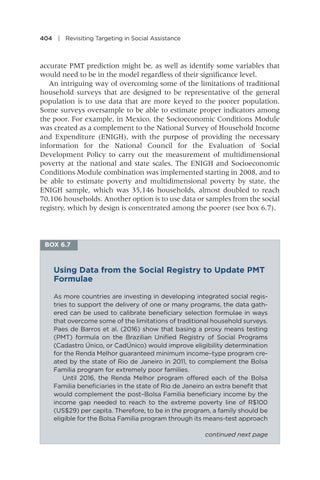404 | Revisiting Targeting in Social Assistance
accurate PMT prediction might be, as well as identify some variables that would need to be in the model regardless of their significance level. An intriguing way of overcoming some of the limitations of traditional household surveys that are designed to be representative of the general population is to use data that are more keyed to the poorer population. Some surveys oversample to be able to estimate proper indicators among the poor. For example, in Mexico, the Socioeconomic Conditions Module was created as a complement to the National Survey of Household Income and Expenditure (ENIGH), with the purpose of providing the necessary information for the National Council for the Evaluation of Social Development Policy to carry out the measurement of multidimensional poverty at the national and state scales. The ENIGH and Socioeconomic Conditions Module combination was implemented starting in 2008, and to be able to estimate poverty and multidimensional poverty by state, the ENIGH sample, which was 35,146 households, almost doubled to reach 70,106 households. Another option is to use data or samples from the social registry, which by design is concentrated among the poorer (see box 6.7).
BOX 6.7
Using Data from the Social Registry to Update PMT Formulae As more countries are investing in developing integrated social registries to support the delivery of one or many programs, the data gathered can be used to calibrate beneficiary selection formulae in ways that overcome some of the limitations of traditional household surveys. Paes de Barros et al. (2016) show that basing a proxy means testing (PMT) formula on the Brazilian Unified Registry of Social Programs (Cadastro Único, or CadÚnico) would improve eligibility determination for the Renda Melhor guaranteed minimum income–type program created by the state of Rio de Janeiro in 2011, to complement the Bolsa Familia program for extremely poor families. Until 2016, the Renda Melhor program offered each of the Bolsa Familia beneficiaries in the state of Rio de Janeiro an extra benefit that would complement the post–Bolsa Familia beneficiary income by the income gap needed to reach to the extreme poverty line of R$100 (US$29) per capita. Therefore, to be in the program, a family should be eligible for the Bolsa Familia program through its means-test approach continued next page


